您的购物车目前是空的!
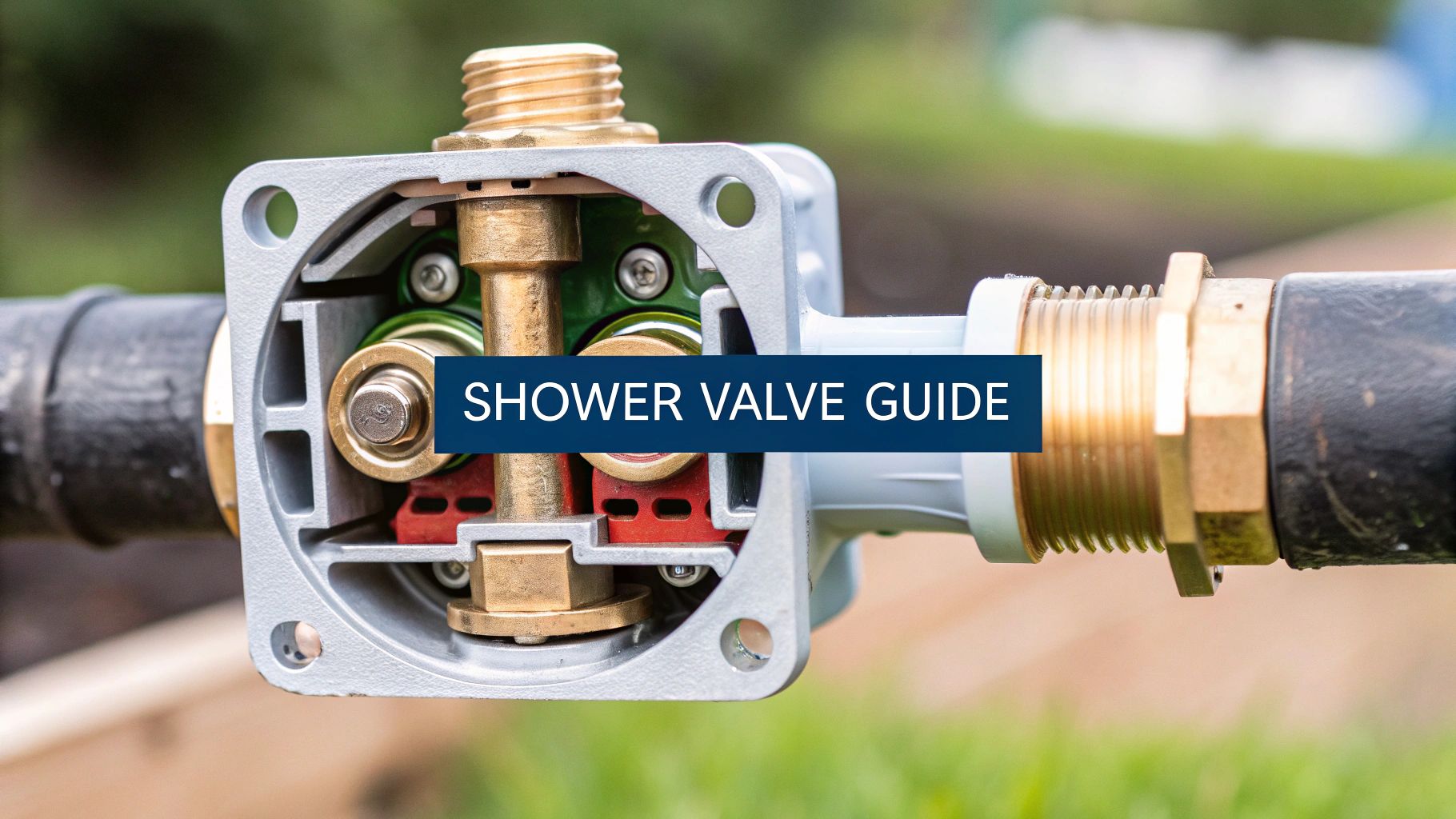
How Does a Shower Valve Work: A Complete Guide
At its heart, a shower valve is your shower's command center, hidden right there behind the wall. Think of it as a traffic controller for water. When you turn that handle, you're actually commanding a small but mighty device to perfectly blend hot and cold streams into a single, comfortable flow.
This section will pull back the curtain and give you a clear answer to the big question: how does a shower valve work?
Unpacking the Role of a Shower Valve
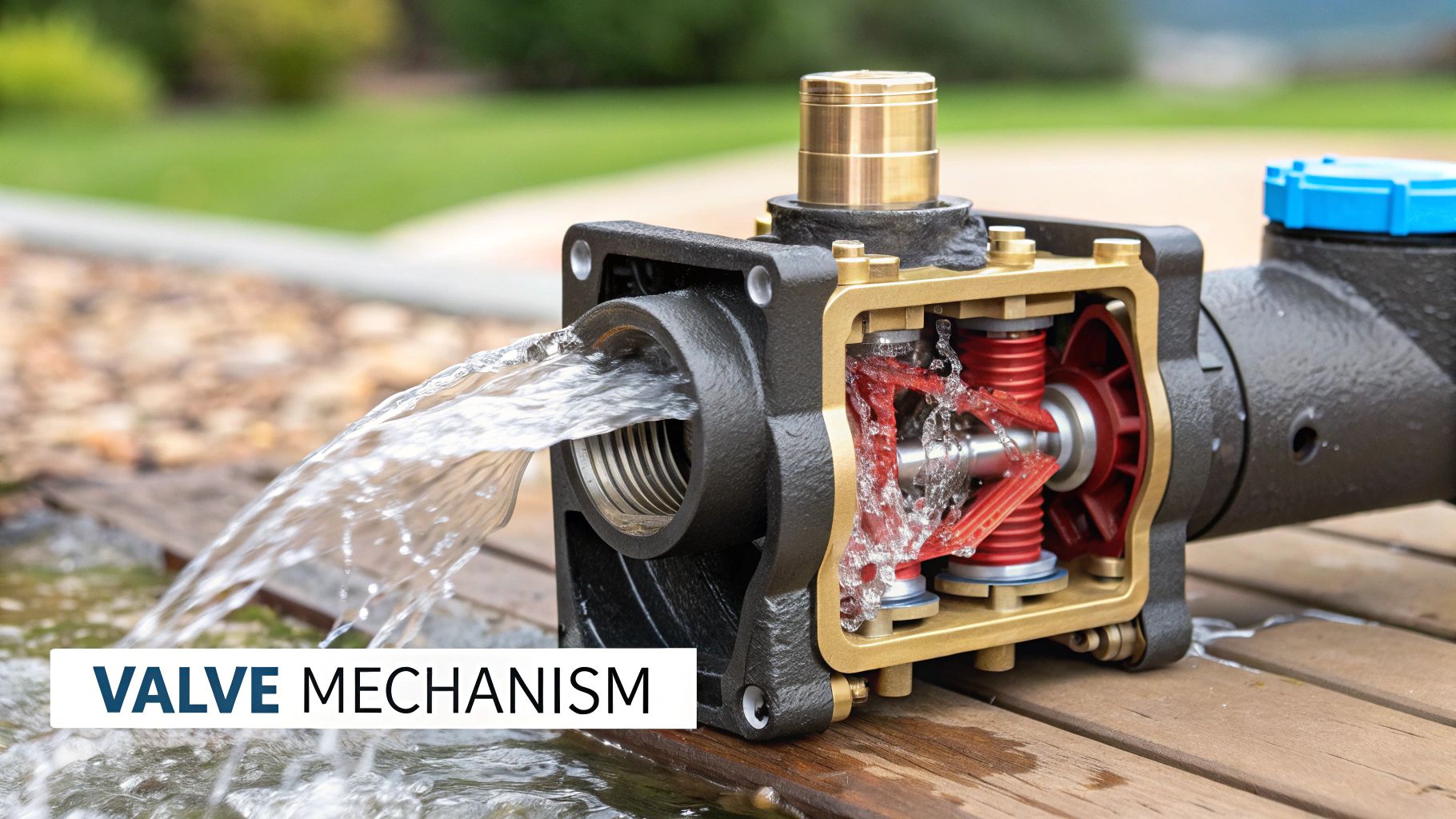
The shower valve is, without a doubt, the most important part of your shower system. It's the unsung hero working tirelessly to make sure your daily shower is both safe and pleasant.
Without it, you'd be stuck manually juggling separate hot and cold taps, constantly trying to dodge a sudden icy blast or a scalding surprise. Its whole job is to manage both water temperature and flow long before the water ever reaches your shower head.
A complete valve set isn't just one piece; it's several key parts working together in harmony. The main players include:
- The Valve Body: This is the heavy-duty housing, usually made of brass, that gets installed inside the wall. It’s the hub that connects directly to your home’s hot and cold water lines.
- The Cartridge: If the valve body is the hub, the cartridge is the "brain" of the whole operation. It’s a small, replaceable part sitting inside the body that controls the water mixing and flow rate as you turn the handle.
- The Handle and Trim: These are the parts you actually see and touch. They’re what allow you to give commands to the cartridge, telling it exactly what you want.
To put it simply, every shower valve, no matter how simple or complex, has three fundamental jobs. Understanding these is the key to knowing how the whole system comes together.
Core Functions of a Shower Valve
| Function | How It Achieves It | Why It Matters for Your Shower |
|---|---|---|
| Control Water Flow | The cartridge inside the valve opens and closes ports to either allow water through or shut it off completely. | This is the most basic function—turning your shower on and off. A good valve provides smooth, reliable control over the water volume. |
| Mix Hot and Cold Water | As you turn the handle, the cartridge adjusts to allow a specific ratio of hot and cold water to enter the mixing chamber. | This is what lets you dial in that "just right" temperature, preventing sudden shocks from water that's too hot or too cold. |
| Regulate Water Pressure | Modern pressure-balancing valves contain a piston or diaphragm that automatically adjusts to pressure changes in the water lines. | If someone flushes a toilet elsewhere in the house, this feature prevents you from getting scalded by keeping the temperature consistent. It's a critical safety feature. |
At the end of the day, these three functions are what stand between you and a chaotic, uncomfortable, and potentially dangerous shower experience. They are the bedrock of any reliable shower system.
More Than Just Mixing Water
Modern valve design has also been shaped by important safety and conservation standards. For example, the U.S. Energy Policy Act of 1992 mandated that shower heads could not exceed a flow rate of 2.5 gallons per minute (GPM). This pushed engineers to design valves that could maintain consistent, comfortable temperatures even at these lower flow rates.
The precision of these internal components is what separates a mediocre bathroom shower set from a high-performance one you'd find from a brand like CRANACH.
Of course, even the best valve won't perform well if it isn't installed correctly. Getting the placement and measurements just right is crucial, and you can learn all about it in our detailed guide on shower valve rough-in dimensions.
A Look Inside Your Shower Valve
To really get what a shower valve is doing, you have to picture what’s going on behind the wall. This is where the real work happens—a clever mix of heavy-duty engineering and fine-tuned mechanics coming together to give you that perfect shower, day in and day out. At the heart of any quality shower system is a core set of components built to last.
It all starts with the valve body. This is a hefty, solid piece of brass that acts as the foundation for everything else. Think of it as the central hub, or maybe the engine block of your shower. It’s what connects to your home's hot and cold water lines and gives all the other parts a solid structure to sit in.
The Brains of the Operation
Tucked inside that brass body is the single most important part: the cartridge. This is the true brain of your valve set. When you grab the handle and turn it, you’re actually controlling this cartridge. It’s a remarkable little device that translates that simple twist into precise control over the water, mixing hot and cold through a series of tiny ports and seals. A top-notch cartridge, like the ones you'll find in a CRANACH bathroom shower set, is what gives you that smooth handle feel and a long, leak-free life.
And if that cartridge ever does wear out down the road? No problem. It's designed to be replaced. We've got a full guide on how to do just that right here: how to remove a shower cartridge.
Key Components for Safety and Comfort
Beyond just mixing water, modern valves are packed with critical safety features that keep you and your family safe from sudden, dangerous temperature changes.
- Pressure-Balancing Spool: This is your first line of defense against scalding water. It’s a small but mighty piston that reacts instantly to any sudden shift in water pressure. If someone flushes a toilet elsewhere in the house, the cold water pressure drops. The spool senses this immediately and cuts back the hot water flow to match, keeping your shower temperature stable within just a few degrees. According to the pros at the International Association of Plumbing and Mechanical Officials (IAPMO), this isn't a luxury—it's a must-have for any modern home.
- Temperature Limit Stop: This is a much simpler but equally effective safety feature. Often just a small plastic ring, it physically stops the handle from being turned into the dangerously hot zone. You can set it during installation to establish a safe maximum temperature, giving you peace of mind, especially with kids in the house.
This simple diagram gives you a clear look at how the hot and cold water flows through the inlets and comes out as one comfortable, mixed stream.
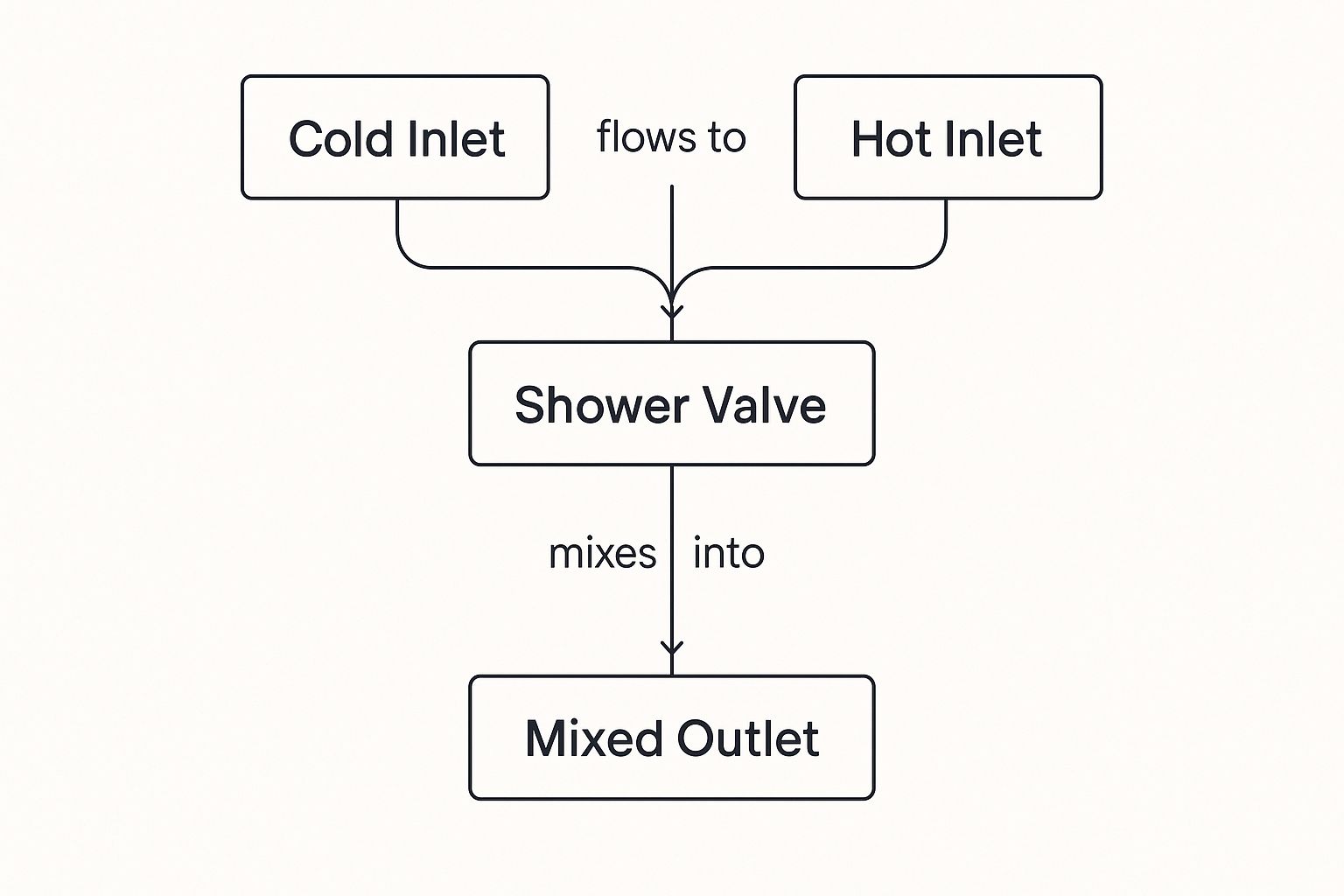
It perfectly illustrates the core job of any shower valve: taking two different water sources and blending them into a single, perfectly controlled flow.
Choosing the Right Type of Shower Valve
When you're planning a new bathroom shower set, picking the right shower valve is one of the most important decisions you'll make. This isn't just a piece of hardware; it's the heart of your shower, controlling everything from safety to comfort.
Getting a handle on the key differences between the major types will make sure the shower you build performs exactly how you want it to. After all, the best valve is the foundation of a great shower, so it pays to know what you’re putting behind the wall.
The Reliable Standard: Pressure-Balancing Valves
Pressure-balancing valves are the workhorses of the industry, and you'll find them in most modern homes for one huge reason: they prevent scalding.
Imagine you’re in the middle of a perfect, warm shower when someone flushes a toilet elsewhere in the house. That flush causes a sudden drop in cold water pressure, which would normally send a blast of dangerously hot water straight to your showerhead. A pressure-balancing valve stops this from happening.
It has a small internal piston that instantly senses the pressure change and automatically restricts the hot water flow to match. This keeps your shower temperature stable and safe, usually within just a few degrees. It's a key piece of technology recommended by the American Society of Sanitary Engineering (ASSE) to meet modern plumbing safety standards.
The Precision Choice: Thermostatic Valves
If you're after absolute, pinpoint control over your shower's temperature, a thermostatic shower valve is the way to go. It’s a definite upgrade.
While a pressure-balancing valve reacts to changes in pressure, a thermostatic valve reacts to the actual temperature of the water. It uses a wax element that expands and contracts with the slightest temperature fluctuation, tweaking the hot and cold water mix to hold your preferred setting.
This means you can dial in your ideal temperature—say, 100°F—and the valve will keep it right there. It won't budge, even if water pressure changes or the incoming water temperature fluctuates. This makes it a fantastic choice for a high-end shower system or for homes with kids and elderly family members where that level of consistency is non-negotiable.
For a closer look at different valve designs, check out our guide on the types of faucet valves for more details.
Directing the Flow: Diverter and Transfer Valves
Diverter and transfer valves have a completely different job. They don’t mix hot and cold water; their role is to tell the water where to go.
- Diverter Valve: This is the simple switch you're probably familiar with. It sends water from the tub spout up to the showerhead. It's the most basic way to manage two outlets.
- Transfer Valve: This is for the more complex, custom bathroom shower set. If you have multiple features—like a fixed showerhead, a handheld sprayer, and body jets—a transfer valve set lets you switch between them or even use some at the same time.
To pull off a truly customized shower experience, a quality transfer valve set is essential. The CRANACH shower system below is a great example of how these advanced valves come together to give you ultimate control.
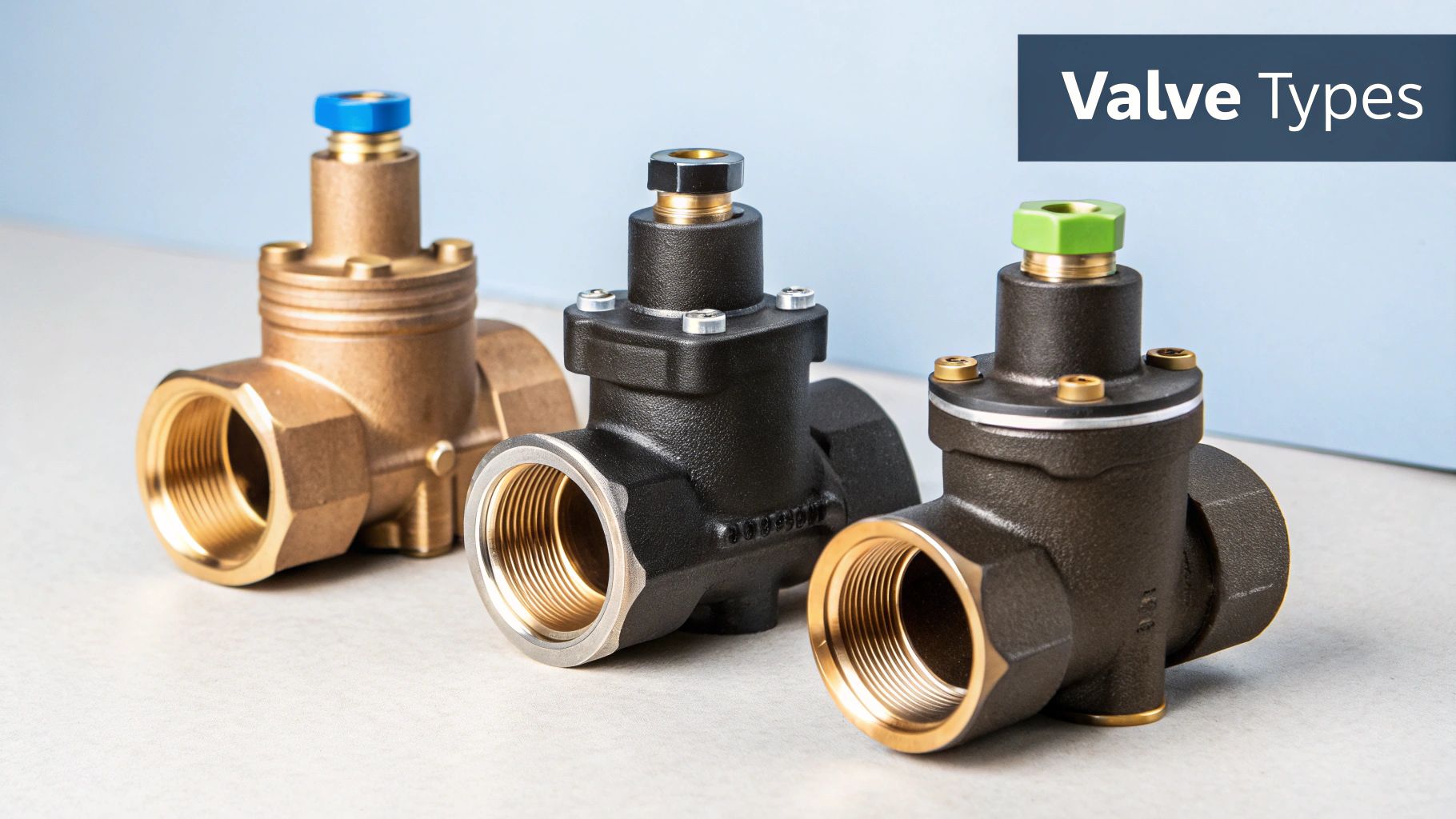
This sleek, modern shower system elegantly integrates multiple functions, all powered by the sophisticated valve hidden behind the wall. It’s the brains behind the beauty.
The Evolution of Shower Valve Safety
The safe, comfortable shower you take for granted today is the result of decades of plumbing innovation. If you've ever used a shower in an older home, you know the drill: two separate handles for hot and cold, and a constant dance to avoid a sudden icy blast or, worse, a dangerous surge of scalding water.
Understanding this journey from basic taps to today's advanced valve set technology shows why modern safety features aren't just a luxury—they're absolutely essential. This progression completely changed our answer to the question, "how does a shower valve work?", shifting the focus from simply mixing water to actively protecting the person in the shower. The goal became creating a shower valve that could almost think for itself, reacting instantly to changes in the plumbing system to keep you safe.
The Single-Handle Breakthrough
A huge leap forward came from a simple, unpleasant experience. In the late 1930s, an American inventor was startled by a sudden blast of hot water from an old two-handle faucet. That jolt of surprise inspired him to create the single-handle mixing faucet, a design that allowed a person to control both water volume and temperature with just one hand.
This invention was a turning point. It laid the groundwork for the pressure-balancing and thermostatic valves we all rely on today. You can read more about this key invention from the American Society of Mechanical Engineers (ASME). It proved that a shower valve could be intuitive, convenient, and safer, all at once, moving the entire industry toward building safety right into the valve's core function.
Today, anti-scald technology is so crucial that many local building codes now mandate its use in all new construction and major renovations. It's the baseline of safety for every modern home.
Modern Safety Standards and Advanced Systems
That focus on safety has only grown stronger. Modern engineering has given us incredibly responsive pressure-balancing spools and wax-based thermostatic cartridges that maintain water temperature with remarkable precision—often within just a few degrees. These components are the heart of a modern CRANACH shower system, giving you reliable protection against thermal shock.
Investing in a certified, modern valve set is one of the most important things you can do to protect your family. At CRANACH, we build our bathroom shower set options around these proven safety principles. If you're ready to upgrade to a safer, more reliable shower system, you can find a local dealer through our store locator. For trade professionals, we invite you to explore our CRANACH Pro program for exclusive benefits and wholesale pricing.
Troubleshooting Common Shower Valve Problems
Sooner or later, even the best shower valve is going to act up. Maybe you've noticed a sudden drop in water pressure, or the handle feels like you're trying to arm-wrestle it into submission. These little annoyances can throw a wrench in your daily routine, but knowing how does a shower valve work is the first step to figuring out what's gone wrong.
Most of the time, the problem comes down to a few usual suspects: a worn-out cartridge, mineral gunk from hard water, or O-rings and seals that have simply given up. These are the workhorses inside your valve, and after years of constant use, they wear out. The good news? You can fix most of these issues without calling in a demolition crew to tear open your wall.
The Annoying Drip
That constant drip… drip… drip… from the showerhead is more than just irritating; it's a huge water waster. If your shower won't fully shut off, the culprit is almost always a worn-out cartridge or bad seals inside the valve set. Over time, these parts just can't create that watertight seal anymore, letting a trickle of water sneak by even when the handle is firmly in the "off" position.
If you're ready to tackle this head-on, our guide on how to fix a leaky shower faucet gives you a full step-by-step walkthrough. Often, the best and most permanent fix is just to replace the cartridge.
Weak Water Pressure
Has your once-powerful shower turned into a sad, weak trickle? The problem is likely sediment and mineral buildup. Hard water is notorious for leaving behind calcium and magnesium deposits that can clog up the inside of the valve body and cartridge, choking off the water flow.
To get things flowing again, you'll need to shut off the water supply, pull the cartridge out, and give it a good cleaning. Soaking it in a bit of vinegar usually does the trick and dissolves the mineral scale. If it's really caked on there, though, just swapping in a new cartridge for your bathroom shower set is the simplest solution.
Sudden Temperature Swings
Nothing ruins a peaceful shower faster than a sudden blast of scalding hot or ice-cold water. Besides being a shock, it's downright dangerous. This is a tell-tale sign that the pressure-balancing spool inside your shower valve is failing. Its job is to react instantly to pressure changes in your water lines, but when it gets clogged or stuck, it can't protect you from thermal shock anymore.
According to plumbing safety experts, a functional pressure-balancing or thermostatic valve is essential for preventing burns, especially in homes with children or elderly residents. Upgrading an older valve is a critical safety improvement.
For a shower experience you can rely on, day in and day out, think about upgrading to a modern CRANACH shower system. Our valves are engineered for precision and built to last.
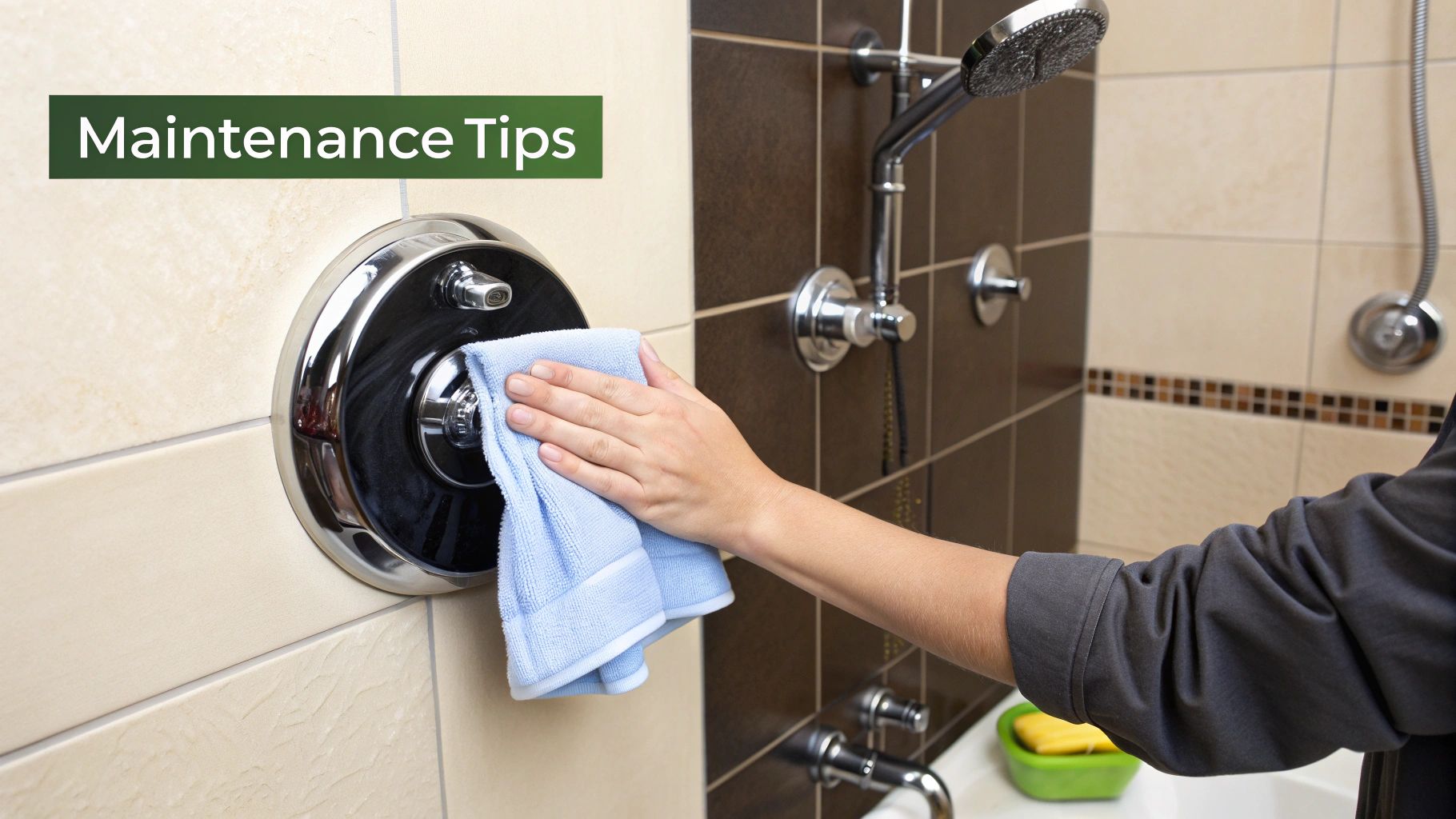
Whether you're looking for a complete shower system or just a replacement valve set, you can find a local dealer using our store locator. And for all the trade professionals out there, we invite you to explore the CRANACH Pro program for exclusive benefits and wholesale pricing.
Upgrade Your Shower with a CRANACH Solution
Now that you’ve gotten a look under the hood at how does a shower valve work, it’s time to think about the right one for your own bathroom. At CRANACH, we're obsessed with blending rock-solid engineering and beautiful design, creating fixtures that genuinely make your daily routine better. That starts with what’s behind the wall—our commitment to durable, all-brass shower valve construction means you're investing in reliability for the long haul.
Tucked inside every CRANACH valve set is a precision-engineered cartridge that delivers seamless control over your water temperature and flow. This focus on quality isn't just a talking point; it's our promise of a consistent, safe, and genuinely enjoyable shower, day in and day out. We also build our valves for no-fuss installation, which has made them a go-to choice for plumbers and contractors who can't afford callbacks. If you want to dive into the specifics, you can explore our premium collection here.
Finding Your Perfect CRANACH System
Whether you just need a standalone valve set to complete a custom build or you're looking for a complete bathroom shower set, we have a solution that fits your vision. Our wide range of shower system options marries our advanced valve technology with stunning, modern looks that feel right at home in any bathroom.

Ready to experience CRANACH quality firsthand? Our store locator makes it simple to connect with a trusted supplier in your area.
For trade professionals, partnering with CRANACH is a smart move. We invite you to check out the benefits of the CRANACH Pro program or ask for a wholesale price. It’s the easiest way to elevate your projects with shower solutions you can stake your reputation on.
A Few Final Questions About Shower Valves
To wrap things up, let's tackle some of the most common questions that pop up for homeowners and even seasoned pros when they're working with shower valves. Think of this as a quick-reference guide to help you make smart decisions and troubleshoot like an expert.
How Do I Know When My Shower Valve Needs Replacing?
Your shower will usually give you a few clear warning signs. Keep an eye out for a constantly dripping shower head, a handle that's suddenly stiff or way too loose, or trouble dialing in the right water temperature. A sudden drop in water pressure can also point to a problem.
If you're noticing any of these, it’s a good bet the valve's internal cartridge has worn out. Swapping it out for a modern CRANACH valve set is a great way to ensure you've got reliability and safety locked in for the long haul.
Are Shower Valve Cartridges Universal?
That’s a hard no. Cartridges are definitely not a one-size-fits-all component. They are built specifically for the brand and model of the shower valve they belong to.
Trying to fit a cartridge from one company into a valve body from another just won't work. For guaranteed performance and a perfect fit, you should always use genuine CRANACH parts for your CRANACH shower system.
Explore the precision-engineered CRANACH valve set collection.
What's the Difference Between a Mixing Valve and a Diverter Valve?
These two get mixed up all the time, but they have completely different jobs. The mixing shower valve is the star of the show—it's the main control that blends hot and cold water to give you that perfect temperature. This is the part doing all the heavy lifting for your comfort and safety.
A diverter valve, on the other hand, is more like a traffic cop. It simply directs that already-mixed water to different places, like switching the flow from the tub spout up to the shower head. Many modern bathroom shower set options now combine both of these functions into a single, clean-looking control.
Should I Attempt to Install a Shower Valve Myself?
While some really experienced DIYers might be able to pull it off, we always recommend hiring a licensed plumber for this one. Installing a shower valve means getting behind the wall and messing with your home's main plumbing lines.
Even a tiny mistake can lead to major leaks and some seriously expensive water damage down the road.
According to the pros at the Plumbing-Heating-Cooling Contractors Association (PHCC), getting a professional installation is the only way to be sure your plumbing is up to local building codes and will operate safely for years to come.
Having a pro install your CRANACH shower system guarantees a secure, leak-free job and gives you total peace of mind.
Discover a complete bathroom shower set that fits your style.
Ready to upgrade your bathroom? Find a CRANACH dealer near you using our store locator. For trade professionals, we invite you to explore the benefits of the CRANACH Pro program and request wholesale pricing to elevate your projects.

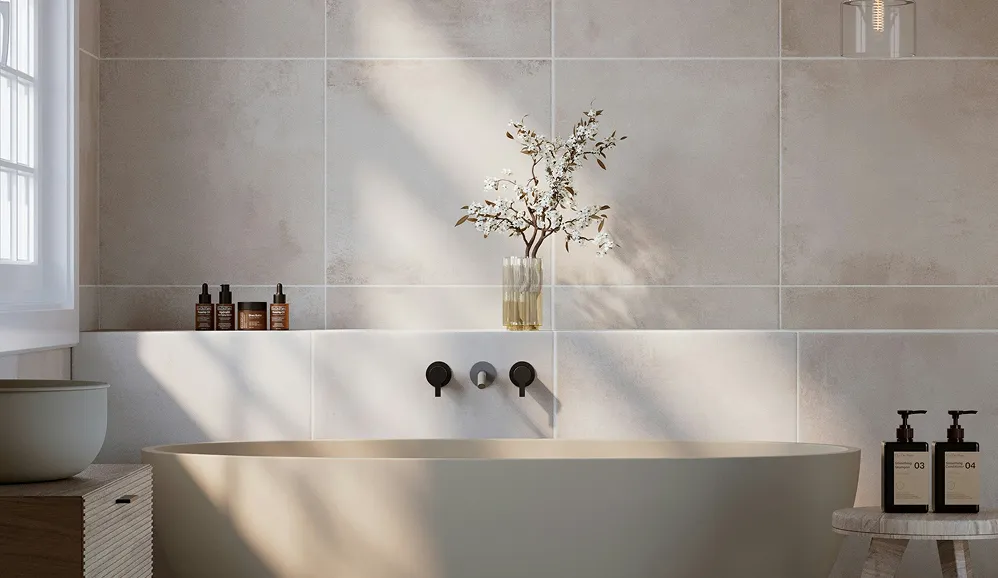
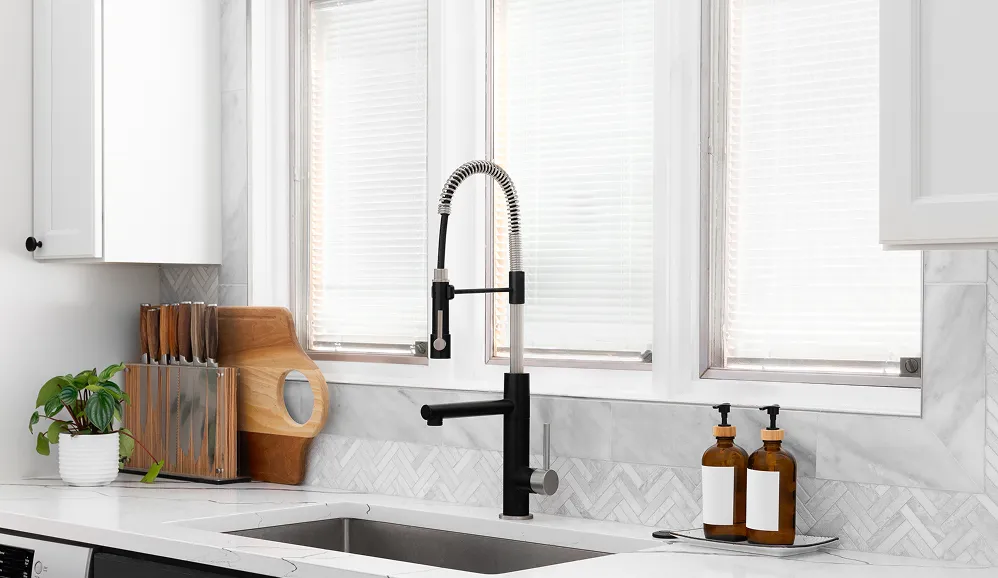
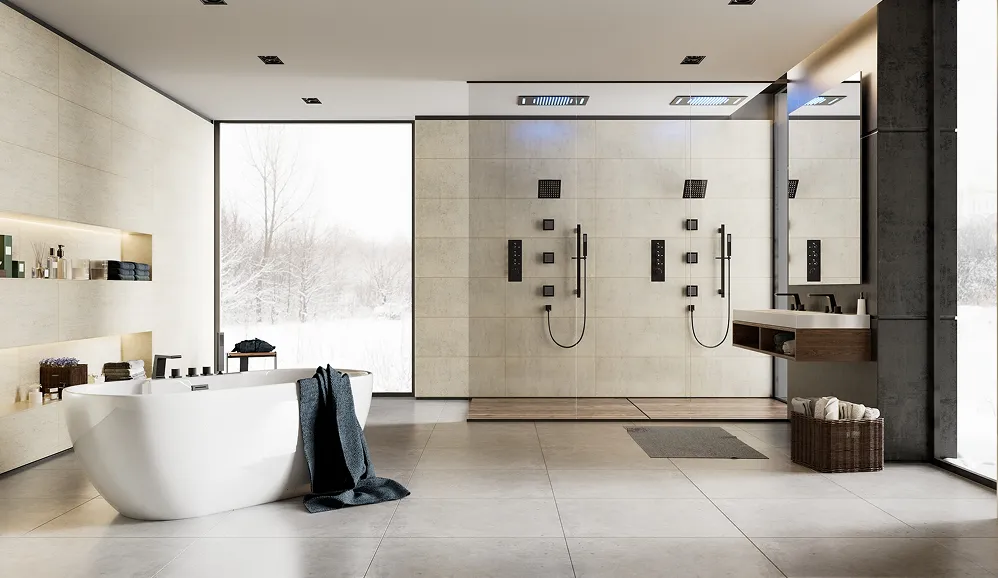
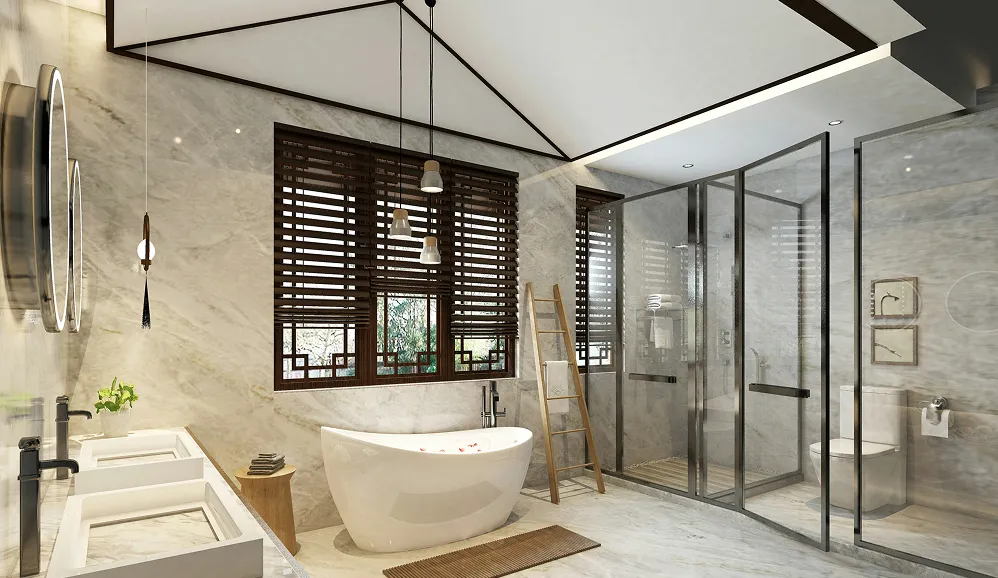

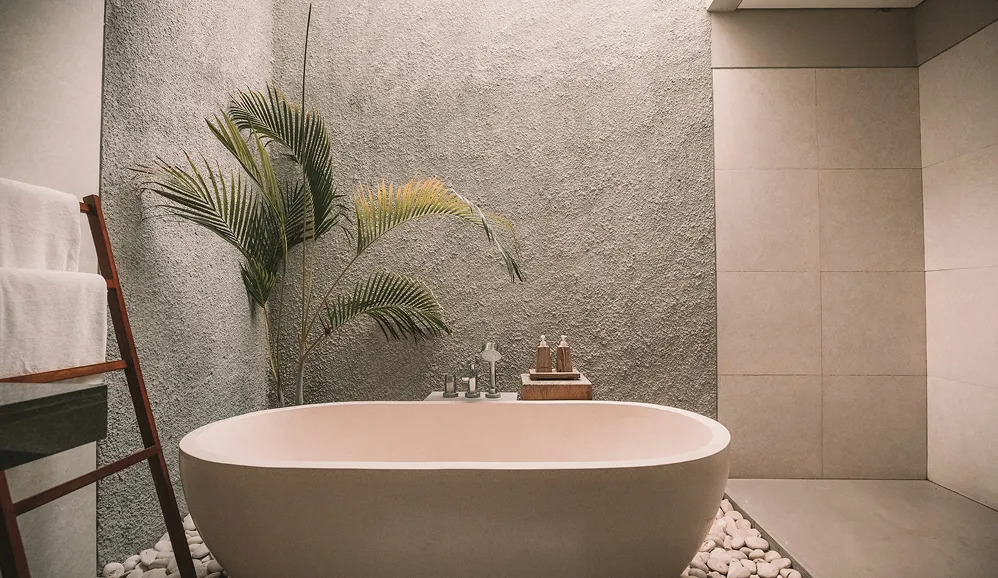
Leave a Reply